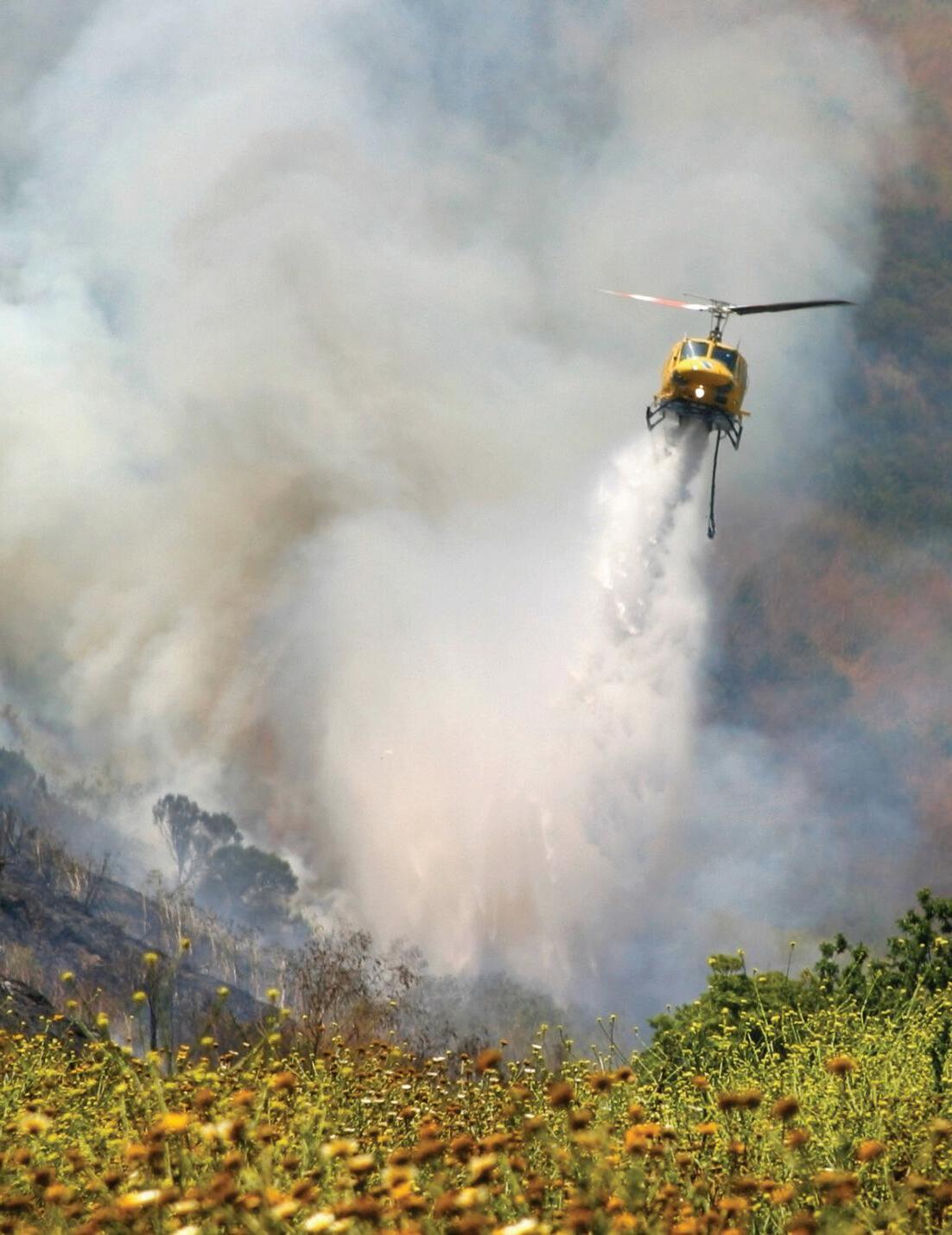
CERT RESPONDER MAGAZINE ® Serving Those Who Serve Their Communities Winter 2019 Crowd Control and Social Engineering San CountyDiego Fire CERTAuthority Training for Fire CERT Preparing for New Madrid Automating Volunteer Hour-Tracking

Springfield, Missouri at the Oasis Hotel and Convention Center
Pre-conference training
July 13th thru 15th, 2020
Main Conference
July 15th thru 18th, 2020
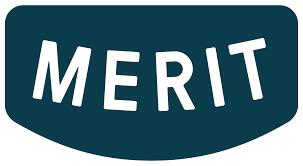
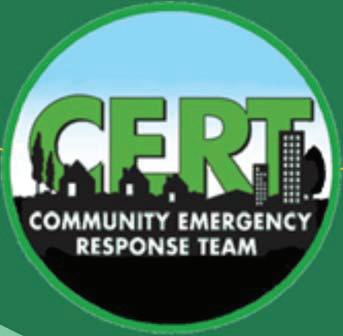
The 2020 �a�onal CERT Conference will bring together thousands of people who all have one goal: a Vision for the Future of CERT. Members from the public and private sector, as well as many trained volunteers will join together to renew the focus of CERT. This partnership reflects one of the most diverse, yet unified groups of dedicated public servants. �t is vital that we con�nue to grow in numbers, partnerships and knowledge. The 2020 CERT Conference will offer an open environment for personal and collabora�ve efforts, as well as increasing knowledge in available technology and networking, all in an effort to grow our vision: a Vision for the Future.
�or roo� reser�a�o�s� yo� ��st call the hotel directly! �or �otel �eser�a�o�s call ���������������

Mission:
CERT Responder
ADVERTISE:
SUBSCRIBE

Staff
PUBLISHERS: Bob Abrams, Fran Sherman Chris Wahoski
CONTRIBUTING WRITERS: Julie Case, Jonathen Davis, Vin DiTizio, Teresa Greenhalgh, Mark Rosenblum, Ken Skalitzky, Chris Wahoski, Jim Watkins
EDITOR/CREATIVE DIRECTOR: Fran Sherman
DIRECTOR OF MARKETING: Bob Abrams
OFFICE MANAGER: Chris Wahoski
CARTOONIST: Matt Marino
YOUR STORY: fran@certresponder.com
SUBMIT
bob@certresponder.com
to CERT Responder
www.certresponder.com/subscribe ®CERT Responder All rights reserved. Photocopying, reproduction, or quotation strictly prohibited without written consent from the editor or editorial committee. Unsolicited material and/or correspondence cannot be acknowledged or returned, and becomes the property of the CERT Responder. The purpose of this publication is to provide a quality publication that educates, informs and connects the CERT and first responder community in the time of crisis, as well as offering a platform for responders to share their stories. To provide comments about CERT Responder Magazine, contact chris@certresponder.com. Inside 06 22 24 20 16 19 16 05 12 10 15 27 26 Departments Features
:
CERT
information
to assist
times of crisis,
well
Automating Volunteer Hour-Tracking San Diego County Fire Authority CERT CERT Preparing for New Madrid Training for Fire Crowd Control and Social Engineering Signs of CO Poisoning. Product Spotlights Teen CERT CERT Spotlight Why Knot? Marketplace Winter Events The official publication of CERT Responder Magazine, LLC. CERT Responder Magazine 2464 Taylor Rd., Suite 202 Wildwood, MO 63040 www.certresponder.com
contact to editor
Sherman,
fran@certresponder.com
Magazine is dedicated to providing
and first responders with
and tools
communities in
as
as offering a platform for responders to share their stories.
To
Fran
send email to
Letter from CERT Responder Magazine
Dear CERT Responders,
As always, we at CERT Responder Magazine want to thank you for your commitment to your communities and those you serve. We want to wish each and every one of you a very healthy and happy holiday season.
In 2020 we look forward to continuing to be part of the CERT Community, and providing you with information from services and other teams around the country.
We value your input and what you think of CERT Responder Magazine. Please continue to share stories from your teams, and please share information about any person from your team that should be in our spotlight.
Thank you for your continued support of CERT Responder Magazine.
We look forward to seeing you at the National CERT Conference in Springfield, MO. In 2020.
“Serving those who serve their communities” CERT Responder Magazine
4 CERT Responder Magazine
PRODUCT SPOTLIGHT

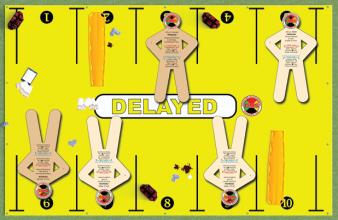



















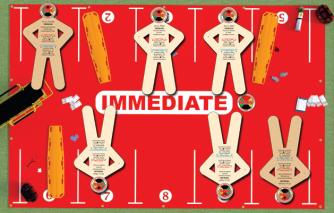








San Diego County Fire Authority CERT
When you hear the statement, “We live in San Diego,” you may picture our CERT members living with all the conveniences you can imagine in the big city. . . widespread cell phone coverage, high-speed internet, an abundance of amenities and beaches just a short distance from our homes. But that is not our reality, because we choose to live in the rural areas of San Diego County.
6 CERT Responder Magazine
So. Division (SDCFA CERT – So. Division) PROGRAM IN ACTION
TERESA GREENHALGH, PROGRAM MANAGER SDCFA CERT - SO. DIVISION
As residents and CERT members in the Southeastern portion of San Diego County, we live with spotty to no cell phone coverage in many areas. The various cell phone carriers work in some communities, while others do not. Highspeed internet is something we know our family and friends enjoy in the city. We live with dial-up (yes, I said dial-up), satellite or no internet. We live in rural and mountainous communities that have snow during winter, hot summer temperatures, Santa Ana Wind events in the Fall, and in recent years, “a year-long fire season.”
Back in 2017 we found ourselves, and many of our neighboring communities, trying to prepare and train for a new hazard in our rural areas of San Diego County. If you by chance have watched the national news coverage in October 2019 about the fire storms and extremely strong Santa Ana Winds in California, you by now are aware of the new hazard we have learned to be ready to respond to, known as the Public Safety Power Shut-offs (PSPS).
Looping back to our rural community reality, we would like to paint a picture that may be unimaginable to someone not living in the rural areas of San Diego County or in an urban environment, no power does not solely mean “no power,” because we live off of well-water.
As with other CERT Programs, we have learned to tailor our program support to meet the needs of our sponsoring and supervising agencies, as well as the 20+ hard to reach rural communities we serve.
When the power is de-energized to help mitigate fire risk, we are cut off from the world for days at a time. No power, no heat, no water, no phone service (cell or landline), no way to call for help, or receive a reverse 9-1-1 call to evacuate, and unless you have a propane gas stove you can ignite, then you also cannot cook a meal or enjoy a hot cup of coffee or tea.
As with other CERT Programs, we have learned to tailor our program support to meet the needs of our sponsoring and supervising agencies, as well as the 20+ hard to reach rural communities we serve. Don’t get me wrong, we do strictly adhere to our CERT training. However, we have learned to supplement our CERT training with non-traditional

training that builds upon the skills we learn in the Basic CERT Academy and the Advanced CERT Modules.
Over the years, our CERT Program has learned to be “creative and think outside the box” in our emergency preparedness training and outreach, not only for the team members, but also for the residents in our rural communities. To address the needs of our residents that are “cut off from the world,” we have accentuated our CERT training with resources that are somewhat outside of the normal CERT resources, and invite residents to join us at some of our monthly training. Not only has this kept our CERT members engaged and well-trained, but it has been a great recruiting tool for our Basic CERT Academy.
We have developed a Mission Task: Welfare Checks Training using materials from FEMA, the Basic CERT Academy, and CERT Animal Response I and II to better prepare our CERT members as we check on our most vulnerable residents following a wildland fire or during a PSPS. Our non-traditional outside training has included: Ham Radio Licensing, Point of Distribution (POD) Training, Mental Health First Aid Certification Training with Mental Health America, and a few of us have added Critical Incident Stress Management Training with the Rock Church and K-Love Radio’s

CERTResponder.com 7

Crisis Response. These customized training sessions have been a vital resource for the Team as we go door-to-door to check on residents during a PSPS or other natural disaster.
Residents, “feel stressed, frightened and cut off from the world.” Our creative non-traditional CERT training has most recently helped us to set up a POD on Halloween to distribute much needed blankets and water during the latest PSPS. It has also helped us to not just “check” on residents, but to be a listening ear and pass along any life-safety concerns we hear to the proper partner agency. We use our CERT ICS forms to document our activities and any hazards we see along the way. We use one of our most seasoned Ham Radio Operators to be the “base” we check in with as we begin our deployment, while on our routes to call in hazards that need to be immediately addressed and then again when we return to the Incident Base Camp. We follow leads from residents to check on people they know that are in very difficult situations. We are all working together to be better prepared for our new hazard as well as the usual natural disasters

We have developed a Mission Task: Welfare Checks Training using materials from FEMA, the Basic CERT Academy, and CERT Animal Response I and II to better prepare our CERT members as we check on our most vulnerable residents following a wildland fire or during a PSPS.
we train for on a regular basis.
Yes, “we live in San Diego,” with challenges that not every San Diegan lives with, but we would not have it any other way. We take pride in the uniqueness of our CERT Program, the services we provide to our family, friends and neighbors, the partnerships we have created with CAL FIRE San Diego, several of the other local CERT Programs, our five Fire Safe Councils, Red Cross, Mental Health America-San Diego, and the Tzu Chi Foundation. We will continue to develop a CERT Program that addresses the individual needs of the communities we serve and look forward to the road ahead with a vibrant Emergency Preparedness Outreach Campaign thanks to the support of our Governor in California! Teresa Greenhalgh, the author of this article, is the volunteer CERT Program Manager with the San Diego County Fire Authority CERT – So. Division Program. If you want to learn more about what the San Diego County Fire Authority CERT –So. Division Program does, please check out our website: http://sdc facert-sdiv.com or catch up with her at the 2020 National CERT Conference in Springfield, Missouri. CERT

8 CERT Responder Magazine
GROUND FLOOR OPPORTUNITY FOR THE RIGHT PERSON!
CERTResponderMagazine is searching for an aggressive and experienced salesperson to present our magazine to potential advertisers. This position is commission driven with incentives.
CERTResponderMagazine is quickly becoming the go-to source for CERT groups to share stories, information, and training tips.
If you feel you have what it takes, please send your resume and contact information to Bob@certresponder.com


Each patient room is large, private and comfortable featuring noise-reduction flooring and ceiling design. All rooms offer improved patient confidentiality, advanced nursing call systems, easier access to imaging services and dedicated patient elevators to reduce patient transport time.
The new hospital features many safe and friendly public spaces and lounges. Visitors and patients alike can visit easily-accessible outdoor healing spaces and courtyards. Plus, convenient parking options dedicated to patients and visitors including valet service. Visit ssmhealth.com/GrandNew for more details







CERTResponder.com 9 JOIN OUR TEAM!
©2019 SSM Health. All rights reserved. SLU-STL-17-312522 8/19 Coming soon in September 2020! Newly designed to promote healing and well-being. Master the Art of MCI Triage in an immersi e D en ironment. There's ne er been an thing close to this. Bra o! - Henrie Watkins - Emergenc Preparedness Ed cator S.T.A.R.T. Triage Online Cer fica on Co rse
able
se
a real mass cas alt incident. Watch the co rse pre ie ideo Get Cer fied Toda at LearnTriage.com Special CERT Member Disco nt Normal . No Onl . ( se promo code CERT at checko t)
As a member of a first-in triage nit, o ill be immersed in a ideo-based lesson plan and learn all aspects of S.T.A.R.T. triage incl ding scene set- p, pa ent care and triage tac cs. This co rse takes o be ond j st kno ing hat S.T A.R.T. is, it ens res o ill be
to
it in


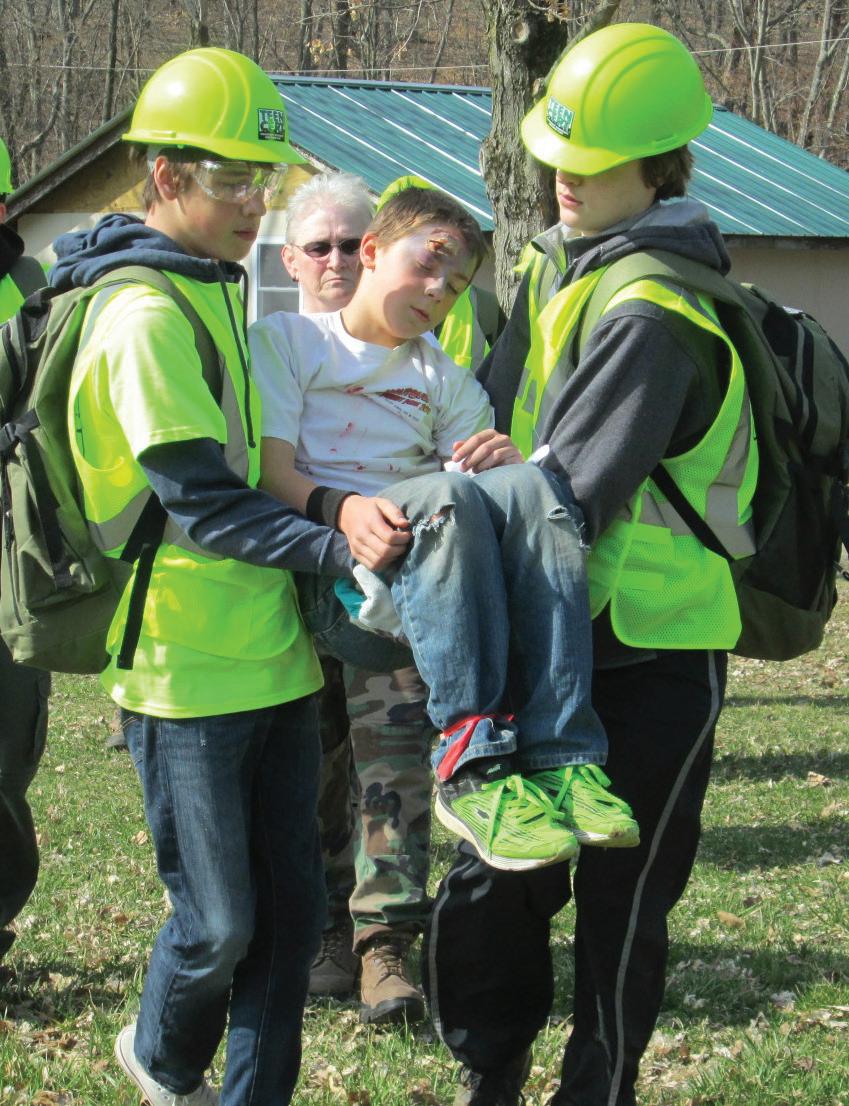
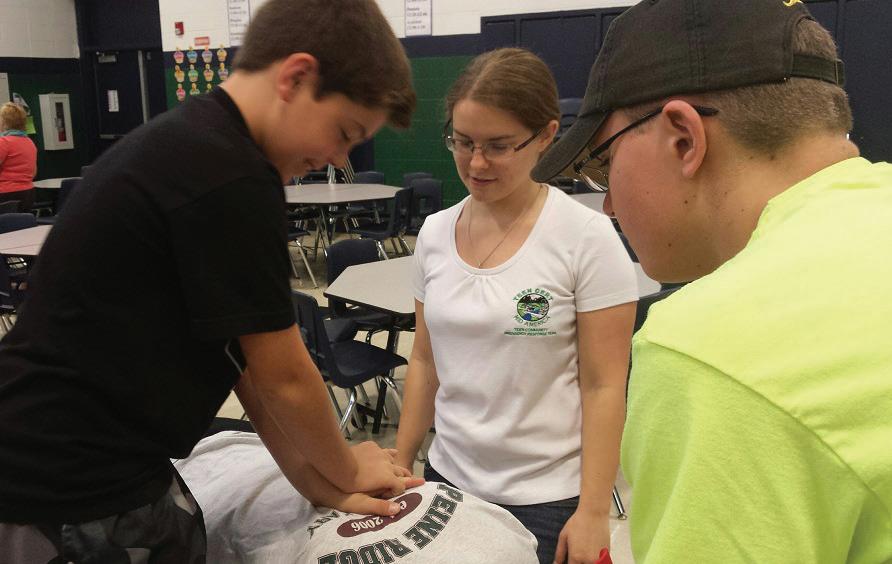
The Need for More Instructors to
TEACH CERT PROGRAM
BY MARK ROSENBLUM, MID AMERICA TEEN CERT DIRECTOR
As the Federal Emergency Management Agency (FEMA) prepares to release their updated CERT Basic curriculum and attempt to reignite the need for municipalities to train volunteers to prepare for the types of disasters that their community may face, the need for more certified instructors will become necessary.
10 CERT Responder Magazine
With more than 2,700 local Community Emergency Response Teams nationwide and over 600,000 individuals trained, qualified instructors who are willing to teach classes continue to be in short supply. Many programs may offer only one or two courses per year and or use professional first responders to teach the curriculum, so the need may not be as critical as teams that hold multiple trainings annually

There are some programs as popular as Mid America TEEN CERT, sponsored through the Wentzville Fire Protection District and the Mayor’s Regional Safety Council, that will continue to increase its ability to train up to eight or more classes per year.
Mid America TEEN CERT put the call out to several of the program’s training assistants to take the CERT train-thetrainer (FEMA G-428) course though the Missouri State Emergency Management Agency (SEMA). Four of the program’s
outstanding adult members completed the class at the Eureka Fire Protection District Training Center. The course is intended to provide an overview of the CERT Basic Training course as well as improve the students’ instructional skills.
Now that Gregory Early, Christopher Matz, Gregory Mercer, and Elizabeth Mercer have met the prerequisite to deliver the CERT Basic Training, they will advance their understanding by attaining their TEEN CERT train-thetrainer (FEMA AWR-188) certification to teach the Mid America TEEN CERT curriculum.
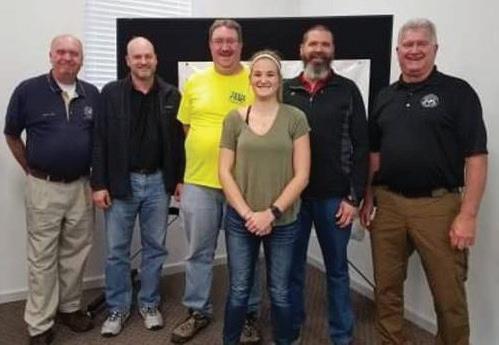
TEEN CERT teaches students to assist local emergency services and their communities in case of a large-scale emergency or a disaster. By taking training, participants have the unique opportunity to go from talk to action and to become part of the solution. Working with surrounding cities and municipalities, the program enhances community education and strengthens mutual aid between police and fire departments, as well as businesses and organizations, should a catastrophic emergency occur.
Since the Mid America TEEN CERT program continues to grow, the need to schedule additional classes and instructors has increased. The program teaches an average of 7-8 training classes and carries out 10-12 charitable events per year. Each class is 22-24 hours and is personally designed to suit each requesting organizations’ needs. The average class size is 25-30 students, with some being as large as 75-100 participants. CERT

CERTResponder.com 11
For additional information about TEEN CERT training or to schedule a class, visit Mid America TEEN CERT on Facebook, or contact program director Mark Rosenblum at mark.rosenblum@outlook.com.
CERT SPOTLIGHT

Focus On

Joseph Braunreuther
Division Coordinator
Suffolk County CERT
WHAT IS THE BEST PART ABOUT BEING A CERT COORDINATOR?
The best part about being a Cert Coordinator is the people I work with. If you noticed I did not say the people that work for me .We are all just volunteers like-minded in helping people.
The group of members I work with are capable to step into any role that has to be filled. And upon a request, if they are available, will fill any role needed.
WHAT DO YOU CONSIDER YOUR GREATEST ACCOMPLISHMENT?
What I consider to be my greatest accomplishment is to be able to communicate with people. Weather it is with my CERT Division, any CERT member or the people I am training or just helping I can usually get my message across.
I wasn’t always like that. I was quiet and shy and would always stand back and let the other person handle the situation. I feel being a CERT instructor gave me the confidence I needed to talk with all kinds of people. I now try to solve problems rather than create them.
WHAT DO YOU DO FOR FUN?
I like most people have hundreds of acquaintances but very few friends. I don’t drink, I don’t smoke , and I won’t hang out in bars. I enjoy being in the company of my wife and the few friends I have.
I have a log cabin in the Catskill Mountains and I hunt. I enjoy hunting with the same friends that I hunted with for the last twenty or so years. I am at the age now that if I don’t get anything in the hunt it’s OK, maybe next year.
HOW CAN THE PUBLIC SAY “THANK YOU” AND MAKE YOUR WORK EASIER?
Just by saying thank you.
All CERT’s including myself are not there for the money. Unlike firemen or police their are no benefits to being a CERT, other than to help people. That’s one of the reasons when we train a class you may see only 20-25% of the people you trained back at meetings or events. The big thank you is in the members that we see again.
WHAT WOULD MAKE MY WORK EASIER?
I feel the one thing that would make my work easier is uniforms. The general public will not respect a man or woman trying to help them in jeans and a tank top, and everybody has an ID badge but people will respect a uniform. It’s a symbol of authority. I feel that a volunteer shouldn’t have to pay for his or her clothes.
HOW
LONG HAVE YOU BEEN IN CERT?
I joined CERT just after 911 so it’s just about 15 years that I’ve been a member. At that time I tried to become a Fireman but the Fire Department said they didn’t need me. CERT was looking for members and it gave me an opportunity that made me feel that I can help in some way.
I have been a CERT instructor for about 13 years and over the years I have taught every Discipline in the CERT manual.
I have been a CPR/First Aid Instructor for the American Heart Association and I just started my 13th year.
And I have been a CERT Coordinator for two townships for 13 years. CERT
12 CERT Responder Magazine



CERTResponder.com 13 CERT-OON Tell the CERT world your story and why your team is special. Contact Bob@certresponder.com for further details or information.



14 CERT Responder Magazine Name:_____________________________________________________________________________________________________ Company:_________________________________________________________________________________________________ Address: ___________________________________________________________________________________________________ E-mail address: _______________________________________________Telephone: __________________________________ Payment Method: ❏ Check ❏ Charge: Credit Card Number:__________________________________________Expiration Date:_____________Security Code:_______ How did you hear about us? __________________________________________________________________________________ Subscribe Now! SUBSCRIBE ONLINE to CERT Responder: www.certresponder.com/subscribe MAIL PAYMENT OF $24.99 TO: CERT Responder Magazine | 2464 Taylor Rd., Suite 202 | Wildwood, MO 63040 CERT RESPONDER MAGAZINE Subscribe Now to CERT Responder Magazine at www.certresponder.com
WATER KNOT

USES
INSTRUCTIONS
2. Pass the end through it
PART 10 IN OUR ONGOING SERIES
• Safely secures webbing, belts and straps together.
• Making grab handles and slings or quick draws
• Firefighting and rescue operations
• Building hammocks
• Setting up slacklines
1. Make a loop with the blue strap
3. Semi-tighten & pass the red strap through the knot
4. Pass the red end to the back
5. Pass it through the frontal wrap of the blue knot
6. Tighten both ends
7. The knot is made.
The WATER KNOT (also tape knot, ring bend, grass knot, or overhand follow-through) is a knot frequently used in climbing for joining two ends of webbing together, for instance when making a sling. It safely secures webbing, belts and straps together. 7 1 2 6 4 3 5



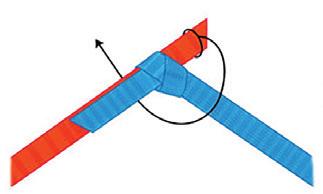
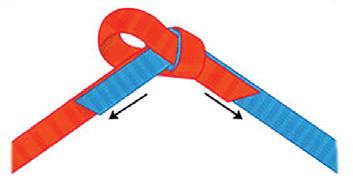
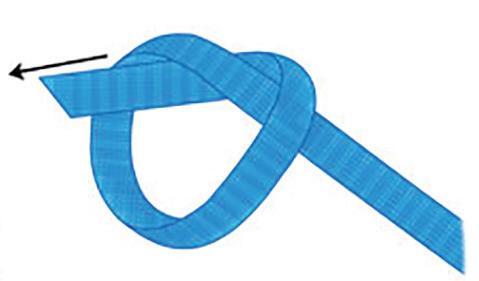


CERTResponder.com 15

CROWD CONTROL AND SOCIAL ENGINEERING
BY VIN DITIZIO, PORT RICHMOND CERT AND RESCUE
For most CERT teams who might be deployed for the New York Marathon, it’s a matter of watching 50,000 people go by in waves. Not so for Port Richmond CERT and Rescue, Staten Island’s CERT team. The race starts here, and involves complex crowd control issues. Crowds can be dangerous, and we’ve all read stories of people getting trampled when things go very wrong.
16 CERT Responder Magazine
The race organization has runners organized by the speed they’ve run in previous races. People are packed so tight that a runner stuck with people faster than him won’t be able to slow down, will tire quickly, and drop out. Those stuck with slower runners won’t be able to speed up. The solution is a series of color coded, fenced in “corrals” with various gates, and 4 waves of runners going through them at various times.
This being an age of terrorist threats, all runners and volunteers must go through metal detectors. No back packs allowed. I don’t know about you, but even when I’m not deployed, my cargo pants are full of all sorts of things I might need in an emergency. My CERT pack has far more. But these security measures are more strict than getting on a plane. So I go in feeling psychologically naked. My tools are gone.
Luckily for us city CERT teams, we are surrounded by thousands of paid first responders. We just need to get them to where we see a problem.
For me it didn’t help that each wave crossing the Verrazzano Narrows Bridge had a ceremony that included cannon fire. It’s a festive part of the race but those are jarring sounds in an age of terrorism.
“Social Engineering” is the phrase used for getting someone to do what you want. It’s often used to describe how con artists and other criminals use it. Another term is “Verbal Judo”. Both sides will be using it, and yours needs to be stronger.
The psychology of runners is all about their TIME. Hence, there will be those who want to get into the wrong gate to increase their chances. We have to visually scan the bibs they wear for the correct corral color, wave and gate.
Our team is in charge of the green corral, gates A- F, and there I stand at gate D with three team members and some race volunteers. We will face thousands of runners going by us and our only tools for this mission are our attitudes, words, and green uniforms.
“Social Engineering” is the phrase used for getting someone to do what you want. It’s often used to describe how con artists and other criminals use it. Another term is “Verbal Judo”. Both sides will be using it, and yours needs to be stronger.
In my decades as a doorman, I’ve had considerable experience dealing
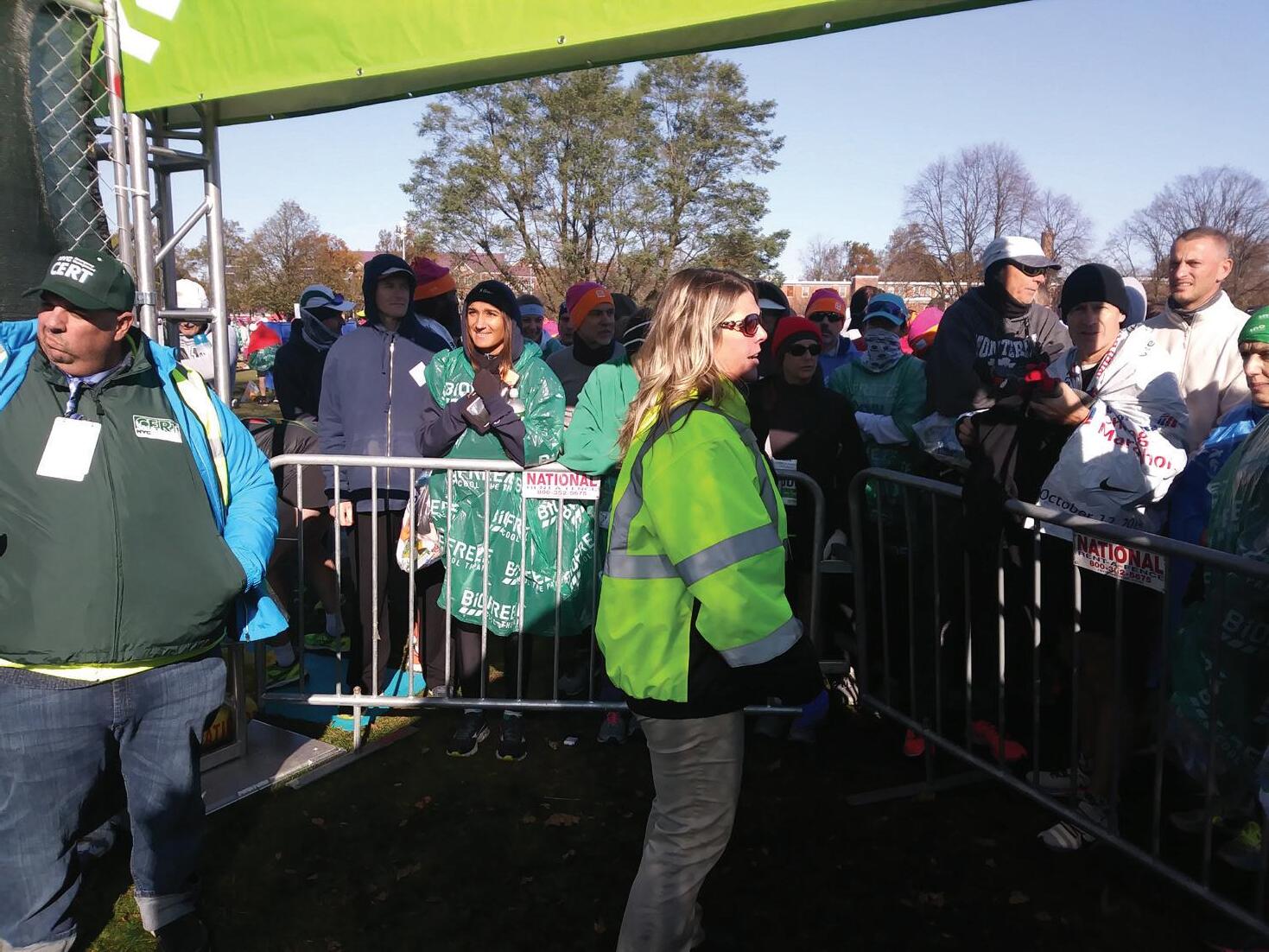
with people. My method is to logically, calmly, and without emotion state that they can’t have what they are asking for. Even more important is that I firmly believe in my mind that what they want is impossible. I believe that it’s not going to happen. This has a magical effect that has to be experienced. Perhaps it changes your body language and tone of voice, or maybe people can sense your energy. When people get the sense that it’s not going to happen, they tend to give up and comply.
To me it’s important to avoid arguing. This could just escalate tensions for them and for you. There are even some personality types that love to argue. A sociopath is an extreme example. Start an argument with one, and they will never stop.
All day I was answering an endless stream of questions about the location of things, armed with only a brief study of the map they gave us.
I have to say that with the thousands that went by us, there was better than 99% compliance with the rules, but it takes only a few to cause a major disturbance.
The biggest need for social engineering is when we close the gate and people arrive late for their wave and want to get in anyway. Many excuses are used. “My friends are in there”, “the race people told us we could get in”, “they told us to come now”, “But we ARE on time”, “PLEASE!”, etc.
My favorite response for one of the most common excuses goes like this: “BUT I’M IN WAVE 2!!!!”
“You’re in wave 3 now. The gates will open in a while.”
Joking with people behind the gate was a helpful tension reliever, and even though my throat was getting sore from
CERTResponder.com 17
There are even some personality types that love to argue. A sociopath is an extreme example. Start an argument with one, and he/she will never stop.
all the talking I also invested the energy to wish people good luck with the race at times. Creating a positive atmosphere tones down disagreements.
A runner having a seizure at gate F had the team there shut it down until EMS could deal with it. Now even more people were allowed through our gate. With people here from all over the world for this race, language issues came up. I just couldn’t get some people to understand when their wave would be. I’d recognize them showing up for every wave and I’d refuse them until they came for the correct one.
One team member at another gate had to call for assistance for people “in his face” with accusations of how terrible a person he was for not letting them through.
Another issue started at our gate with a group wanting to get in early. They ended up at another gate with race officials refusing them. The group’s story was that they had a flight home scheduled for only 15 minutes after their race would end so they needed to get in early. This ended up with one woman in the group on the ground thrashing around
and screaming like she was having a child’s tantrum. From the story I heard, she was cursing us, cursing America, and vowing never to return. No thoughts on just getting a later flight. When emotion spikes, logic is not easily accessible.
My favorite moment that I personally experienced was when an older man with a German accent explained to me that he was disabled, had only one lung, and he wanted his son to pace him, but his son had no bib. He was actually asking me to admit someone who wasn’t even registered for the race. I acted concerned for him (a way of disarming an argument by saying “I’m on your side”) and redirected him to an information tent where he would find out that what he wanted can’t happen. The more people he hears it from, the more likely he will be to accept reality.
All of this was so confusing at times that it made simple team communication difficult.
Scanning 3 bibs a second as the crowd surged past me made it hard to understand what was coming out of my radio, and know how to respond to it.
Did people get past us who weren’t

supposed to? ABSOLUTELY! Chasing down every single offender might create another kind of disturbance. We are looking to get the highest success rate possible, and, like triage, you can’t do it all.
After it’s all over, we end up with a free jacket and a pin thanking us for volunteering. The better thanks comes from the hundreds of runners that thank us as they pass by. And, as all of us volunteers know, the real reward is having served.
Many deployments may have you facing people who want to do something they aren’t supposed to do. The ability to use properly arranged words for the good of all concerned is a powerful tool.
And, like I told the runners, good luck! CERT
Resources- Book:
Verbal Judo: The Gentle Art of Persuasion, by George J. Thompson
Access All Areas: A Guide to the Art of Urban Exploration, by Ninjalicious. A book for people who explore interesting places where they are usually trespassing, including ways to talk their way past people like you.
Left of Bang: How the Marine Corp Combat Hunter Program Can Save Your Life, by Patrick Van Horne. A book about another aspect of dealing with crowds. It’s a precise method of scanning people to know who is likely to become violent.
Other Resources
Wikihow- How to Spot a Sociopath- Identifying and dealing with this particularly difficult personality type. Dealing with them has similarities to dealing with a lot of stressed out people in difficult situations.

18 CERT Responder Magazine
SIGNS OF CO POISONING
BY CHRIS WAHOSKI



Carbon monoxide (CO) poisoning takes the lives 1-3% of the 70,000 affected each year. There are 15,000 Emergency room visits and 500 deaths each year in the United States associated with CO poisoning.
It is a colorless, odorless, and tasteless gas that comes from incomplete combustion of carbon products. This can be your household appliances such as gas fires, boilers, central heating systems, water heaters, and cookers. Open fires that use gas, oil, coal, and wood may also be possible sources of CO gas. It happens when the fuel does not burn fully. Running a car engine in an enclosed space can cause CO poisoning. The World Health Organization suggest anything over 6 ppm can potentially be toxic over long periods of time.
Long term neurological deficits affect approximately 40% of people that survive CO poisoning. CO has 250 times the affinity rate that binds to the heme containing proteins on red blood cells, competing for the oxygen molecule that is supposed to be attached to the red blood cells. It effectively becomes the “big bully,” not allowing
you to get the oxygen you need. It also doesn’t allow the carbon dioxide we exhale to get out of the system as waste.
You should always be checking your appliances if you have gas systems, or some sort of detector that can alert you should a problem arise from you furnace. If you detect a problem, you should call 911 and the gas company to come and repair any malfunctions or issues.
If you have a house fire, are showing symptoms, or are exposed to CO and have symptoms such as headaches, blurred vision, cherry red face, confusion or memory loss, or speech problems, you should be treated at a local emergency room. They will place you on high flow oxygen which should resolve in 4-6 hours. In some areas where a bariatric chamber is available, they might need this to resolve some abnormal lab values. CERT
50%
Only 50% of homes in the United States have working Carbon Monoxide alarm detectors. 75%
Homes have a potential carbon monoxide producer.
70,000
CO events occur every year in the United States.
CERTResponder.com 19

CERT PREPARING FOR NEW MADRID
BY JIM WATKINS
When people think of Missouri and the Midwest, they usually associate it with flooding and/or tornados. That is correct. Also, we have ice storms, heat waves, severe thunderstorms, droughts, and other natural disasters that occur in other parts of the United States.
20 CERT Responder Magazine
Earthquakes are a big topic in Southeast Missouri along the New Madrid Seismic Zone. A local radio station (KZIM/ KSIM) provides daily earthquake updates to keep us aware of earthquake activity where we live. The major difference between most natural disasters and an earthquake in the New Madrid Seismic Zone would be the area impacted. An earthquake magnitude of Mw7.7 in the New Madrid Seismic Zone could/would affect eight states and four FEMA regions. The CERT program does stress that we live in an “all hazard” area, including reference to the 1811-1812 series of earthquakes that made changes in the area. The City of New Madrid, MO partially liquefied into the Mississippi River and riverbanks collapsed into the river along with trees, acting as a dam for a short period of time. Southeast Missouri was a swamp area with sand blows, fractures, and most of the population moved elsewhere. Reelfoot Lake (TN) was formed as land sank, about 15,000 acres, and other areas uplifted. Islands in the Mississippi River disappeared, and others formed.
Recognizing this threat, in the early 1990’s Assistance Fire Chief Mark Hasheider (Retired) and Captain Paul Breitenstein (Retired) of the Cape Girardeau Fire Department brought the CERT program to Southeast Missouri from the Los Angeles Fire Service. The first CERT trailer, purchased with local donations, was taken to Washington, DC for a Project Impact display. Continued trainings have benefited over 4,000 trained in CERT to take care of themselves, their families, and others in the event of a disaster. The programs in Southeast Missouri were funded by Missouri Citizen Corps until funding ended.
The Regional Homeland Security Oversight Committee (RHSOC) recognized the importance of citizen disaster preparedness and funded a position of Disaster Preparedness and CERT Coordinator for the thirteen counties of Region E in Southeast Missouri and equipped nine CERT training trailers. The Coordinator position allows for recruitment of speakers to provide awareness, preparedness, mitigation, response, and recovery presentations and activities to all groups, organizations, and agencies as well as CERT classes when requested by these groups. Currently, Teen CERT is being offered in three local high school settings and several area schools have provided CERT training to their staff members. Businesses have requested presentations and classes for their employees. A recent trend is for churches to request CERT classes for their “security teams” and other groups.
Leah Braswell completed CERT, and volunteered as a Shaken Fury participant to be buried in the rubble. Her observation from being a CERT rescuer and waiting for rescue was very stressful, even knowing it was an exercise. Being unable to move enough to care for the infant (mannekin) placed near her was challenging. The Search Dog found her, but being entombed for three hours as the rescuers worked their way through the building debris was difficult.
The most requests for CERT assistance are for sandbagging. CERT members have assisted with tornado “Health and Safety checks” and as needed with other duties as requested. CERT



CERTResponder.com 21

AUTOMATING VOLUNTEER HOUR-TRACKING WITH MERIT
Lets You Do Less Paperwork and More Life-Saving Work
BY KEN SKALITZKY, FORMER EMERGENCY MANAGEMENT DIRECTOR AT VOLUNTEER FLORIDA
Thirty-six seconds is all it took on May 22, 2011 for a tornado to cause 161 fatalities and 1,800 injuries, as well as destroy 7,500 homes, 18,000 vehicles, 50 businesses, a hospital, and leave over 3 million cubic yards of debris in Joplin, Missouri, amounting to billions of dollars in damages.
22 CERT Responder Magazine
The city of Joplin – like my city, and I’d venture to guess most cities – did not have that kind of money sitting in a rainy-day fund. Fortunately, the Federal Emergency Management Agency (FEMA) covers 75% for federally-declared disasters, which in this instance amounted to a $69.6M public assistance bill to remove debris and rebuild infrastructure and public buildings like schools and courthouses. While that still left the local government on the hook for $17.4M, the 610,000 volunteer hours and donated resources were able to offset the state’s share of the cost.
The city of Joplin is a case study in not only resilience, but in record-keeping following an emergency. Paperwork might be the last thing on your mind in those critical 36 seconds and its aftermath, but it can be the difference between leaving your town bankrupt or not.
Between July and September of this year, there were 133 declarations across 41 states and 10 tribal regions. 26 of these were fire management declarations, 33 for hurricanes or typhoons, and 3 for earthquakes. All of those events have some cost associated with them, and most states aren’t financially prepared. Yet states are required to pay the bill, or have a plan in place to pay the bill before they can ask for further assistance – even if another event were to occur. Therefore, it is extremely prudent – as in the case of the Joplin tornado – to offset the financial burden of emergency responses with volunteer hours.
However, I can tell you firsthand as the former Emergency Management Director for Volunteer Florida, tracking those hours is extremely challenging and rarely a priority.
Emergency managers’ top concern is evacuating people before and protecting people after an event. That same person or small team is responsible for all public needs, including public safety, shelter, and even fixing roads and removing debris following an event. This is a huge mental and physical effort and frankly, accurately capturing volunteer sign-ins is not top-of-mind
In most cases, volunteer effort does not get captured until the very end, which can honestly be years later, in addition to the reality of overlapping disaster recovery operations complicating matters further.
at the time of an emergency. The other reality is that volunteers want to help feed, shelter, and protect people, not fill out paperwork. In addition, volunteers – regardless of whether they are local or coming from elsewhere – likely aren’t concerned about who’s footing the eventual local bill.
In most cases, volunteer effort does not get captured until the very end, which can honestly be years later, in addition to the reality of overlapping disaster recovery operations complicating matters further. Even if it is captured at the time of the emergency, it needs to be saved for years in order to offset the eventual FEMA bill. Meanwhile, people have changed roles, and aggregating years-old records becomes a new challenge. Not to mention that check-in papers often get wet or destroyed at events or lost along the way, and the inevitable
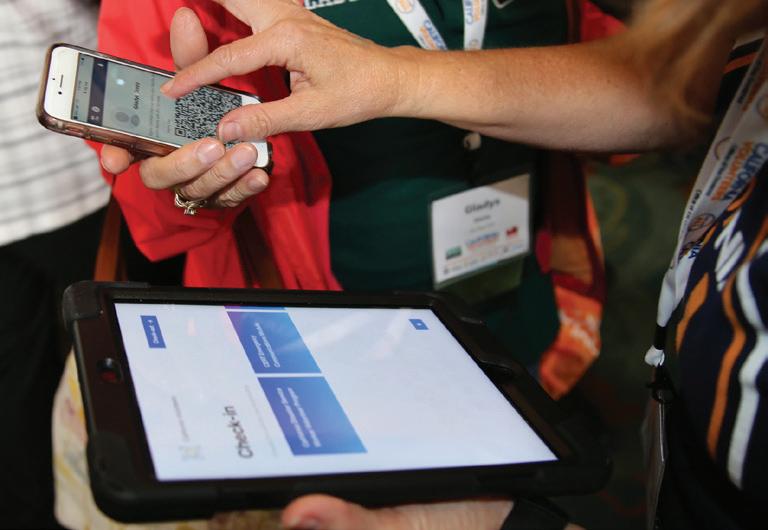
data-entry is prone to human error. The clear solution is to capture hours at the time of the event, and to do it in an automated fashion. Merit is one such platform that automates and simplifies volunteer check-in and hour-tracking at emergency sites, as well as data aggregation and reporting later on. Not only does Merit house a more accurate record of volunteer hours, but the platform facilitates the data reporting and expedites submission. When Mayors and Governors gets better information quicker, the total bill is reduced, and officials can champion emergency services’ work by highlighting how their tax dollars are being offset by the goodwill of volunteering citizens. While the national rate of a volunteer hour is valued at $27.47, documented qualified specialty work can earn even higher rates, making it a vital tool in an efficient reporting process – when properly documented.
More than two years after making landfall, more than $50 billion in federal funds have been provided for recovery efforts for another massive disaster, Hurricane Irma, during which I personally oversaw the volunteer efforts engaged in response and recovery. My estimate is that the state of Florida lost out on $75M in additional offsets due to inadequate records, which was just before we adopted Merit for our records. Lessening the burden on state and local community budgets in the near and long term is a real priority for every official.
Thankfully there are only a few places in the country with recurring major disasters, but emergency managers and community organizers in every town need to use their precious blue-skies time to better prepare themselves for emergency events. Part of that preparation should be finding and implementing standardized, automated record-keeping tools like Merit, so when there is an event, they can focus on meaningful work, not paperwork. Like all good habits, training volunteers to track their hours automatically during blue-skies leads to efficient deployments in the worst of times. CERT
CERTResponder.com 23
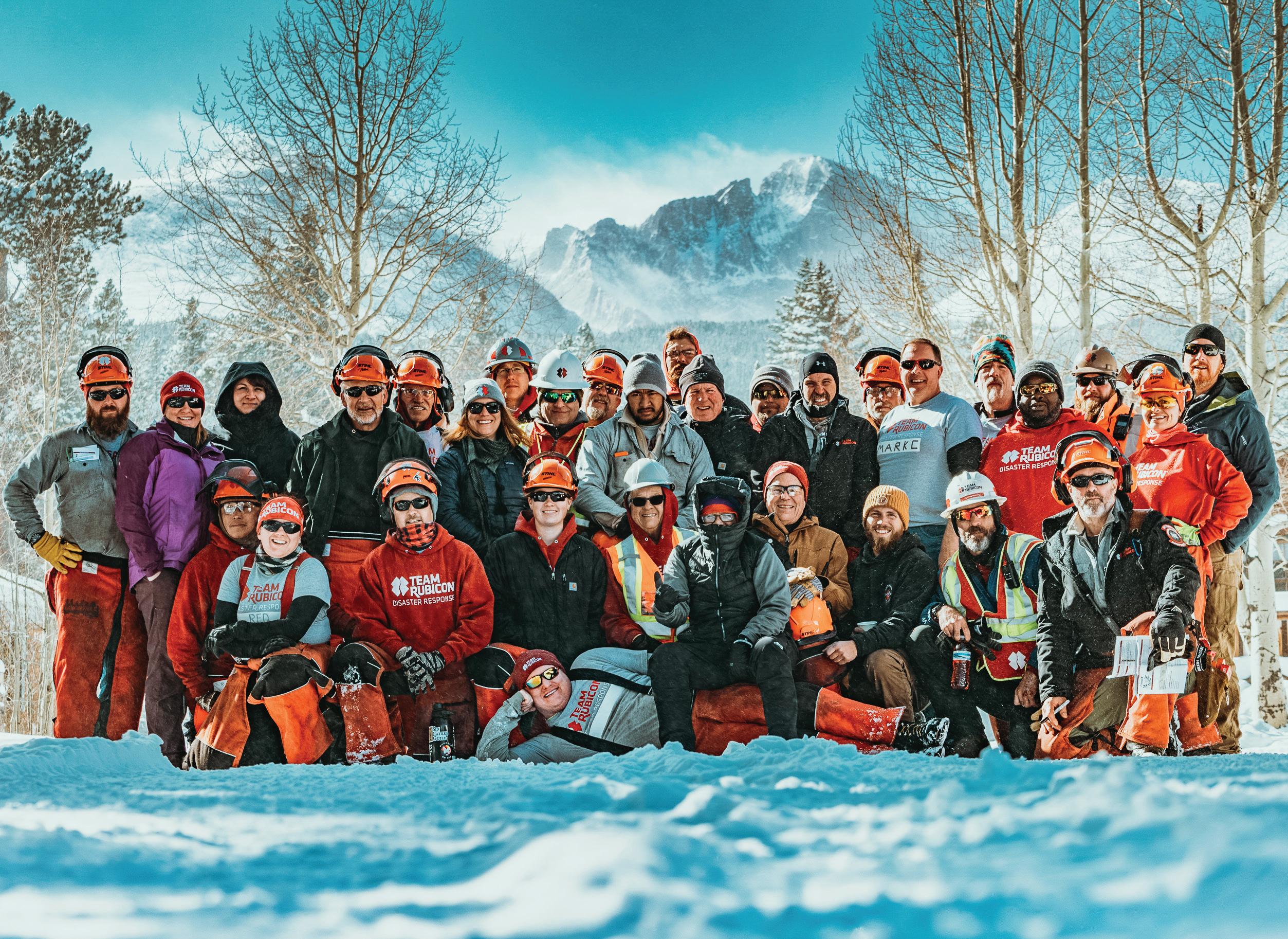
TRAININGFORFIRE
As it certifies emergency responders, a veteran-led disaster relief organization also helps prevent wildfires
BY JONATHEN DAVIS AND JULIE CASE
In the snowy Colorado mountains in early November, dozens of men and women revved chainsaws and powered up skid steers. Some were novice chainsaw handlers and excavator drivers; others were more experienced. They were at the Salvation Army’s High Peak Camp, near Estes Park, to become proficient in chainsaw and heavy equipment operations. While the volunteers cut down trees and moved debris, learning to wield a saw or turn a skid steer with ease, they were also helping the local community with fire mitigation.
24 CERT Responder Magazine
For veteran-led disaster response organization Team Rubicon such trainings, referred to as disaster academies, have become a part of doing business; insurance the non-profit will have highly-skilled volunteers who can deploy rapidly in the wake of a natural disaster. People who can quickly and safely, as the organization is wont to say, “get shit done.”
In an extreme amount of forest in such a place like this, fire mitigation and fuel reduction is always important
Since launching such trainings and disaster academies in 2019, Team Rubicon has trained 693 of its own volunteers— known as Greyshirts—in everything from post-disaster damage assessment to heavy equipment operations. Greyshirts acquired 4,751 hours of training in 2019 alone, and, the organization has already certified 71 people as sawyers level one; an additional 23 sawyers have earned their level two certification.
Because Team Rubicon uses actual disaster sites for training, there’s something in it for local communities, too. In January, for example, after 32 hours of classroom training 68 volunteers practiced their skills by cutting burnt trees and clearing hazards from a fire-devastated ranch in Alpine, California.
For Greyshirts such as Joe Brier, a firefighter and paramedic with Oregon’s Albany Fire Department, the weeklong disaster academies are a win-win. Not only did he earn his heavy equipment operator two certification during the Colorado academy, the fire mitigation services he helped provide also made the job for Colorado firefighters easier.
“As more areas do fire mitigation, it greatly reduces the chance of having a catastrophic fire that puts first responders in harm’s way,” said Brier. “When communities maintain
their areas against potential fires, as it makes it safer for first responders. It also allows us to quickly assess the situation and allocate resources to where they are needed the most.”
As they earned their certifications at High Peak Camp in Colorado, Greyshirts cleared the surrounding forest of fuel. While wildfires have long been a natural occurrence that allows the ecosystem to stay healthy, they also threaten places becoming increasingly urbanized.
“In an extreme amount of forest in such a place like this, fire mitigation and fuel reduction is always important,” said Brian Wallace, High Peak Camp’s assistant director.
Having toppled burnt trees and moved debris moved into piles across the camp, the Greyshirts went on to carve a 900foot fire break that would protect equipment—and a portion of the camp—from future fires.
“With all the beetle-killed trees, the volunteers from Team Rubicon not only made this place safer from wildland fires but also made our activity areas safer for the kids who will enjoy the camp next season,” said Wallace.
Meanwhile, for Greyshirts, that ounce of prevention they provided means they’re also now better equipped to quickly, and efficiently, get shit done when a disaster does strike in the future.
Greyshirts wanted: Team Rubicon is a 501(c)3 nonprofit that utilizes the skills and experiences of military veterans, first responders, and kick-ass civilians to rapidly deploy emergency response teams across the United States and around the world. Join us: www.teamrubiconusa.org/volunteer. CERT

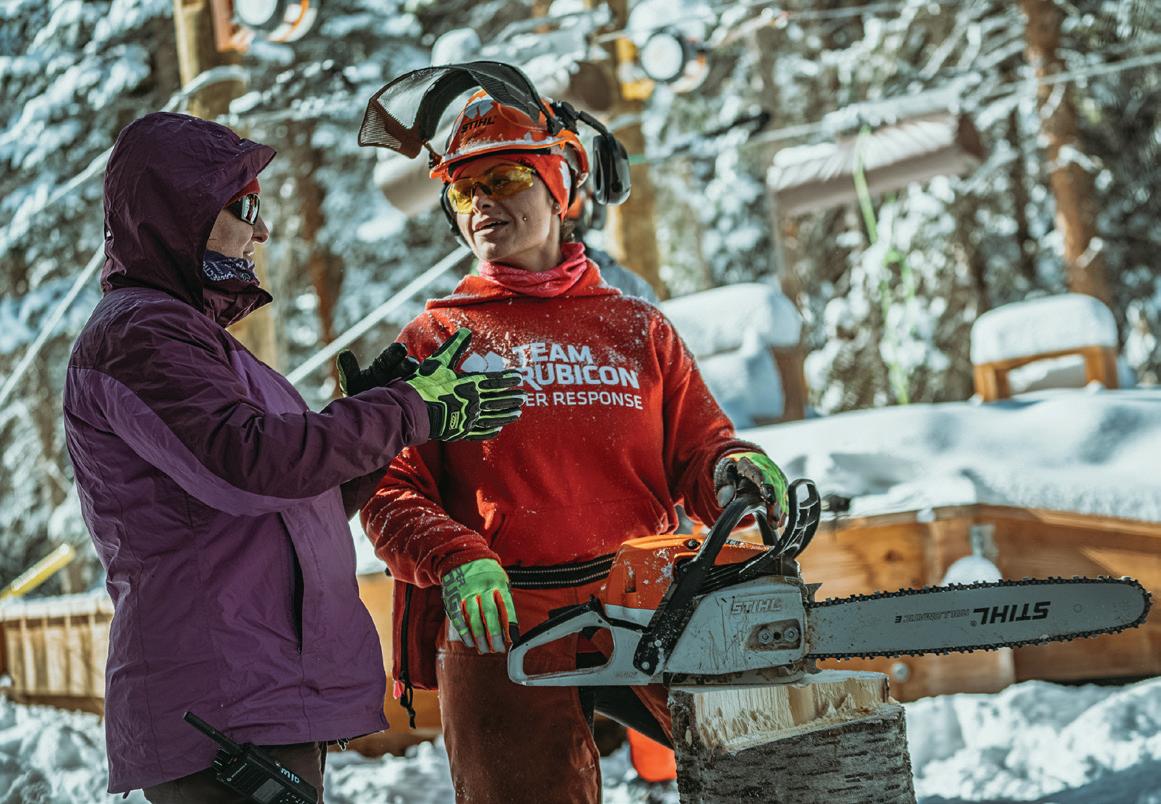
CERTResponder.com 25



26 CERT Responder Magazine CERT MARKETPLACE AGOOD Graphic Design & Creative Direction • Magazines • Publications • Newsletters • Brochures • Advertising • Much More 314.275.2208 shermanstudios.com IS HARD TO FIND Fran Sherman For Design You’ve just found one. tiger@tigertravel.com 314-968-4410 800-875-4410 7967 Big Bend Blvd. Webster Groves, MO 63119 Making Dreams Come True since 1972 TIGER TRAVEL SERVICE Advertise Here Contact Us Today! www.certresponder.com/advertise
WINTER EVENTS
DECEMBER
DECEMBER 3
National Disability Day
DECEMBER 7
International Civil Aviation Day
DECEMBER 25
Christmas

JANUARY
JANUARY 1
New Year’s Day
JANUARY 9
National Law Enforcement
Appreciation Day
FEBRUARY
FEBRUARY 2
Groundhog Day
FEBRUARY 12
Lincoln’s Birthday
FEBRUARY 14
Valentine’s Day

FEBRUARY 17
Presidents Day and Washington’s Birthday
FEBRUARY 25
Mardi Gras Carnival (New Orleans)
CERTResponder.com 27

More life-changing work. Less paperwork. Intelligently track training, qualifications, and volunteer hours with Merit. Sigma is now Merit merits.com | taylor@merits.com





















































































